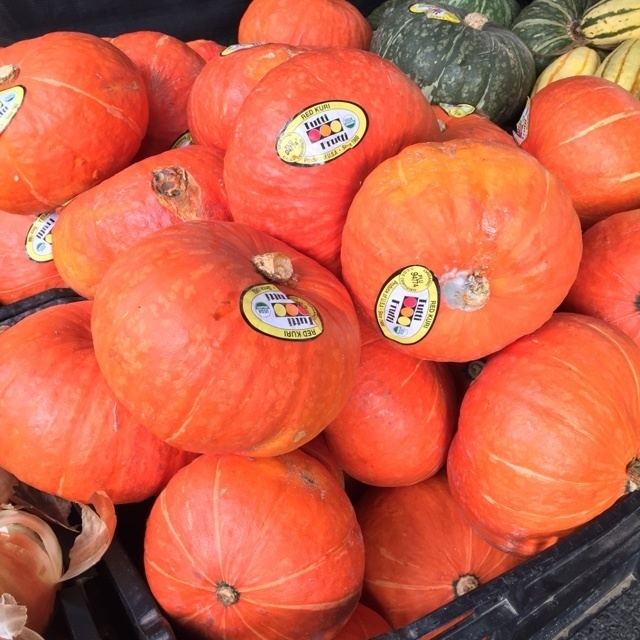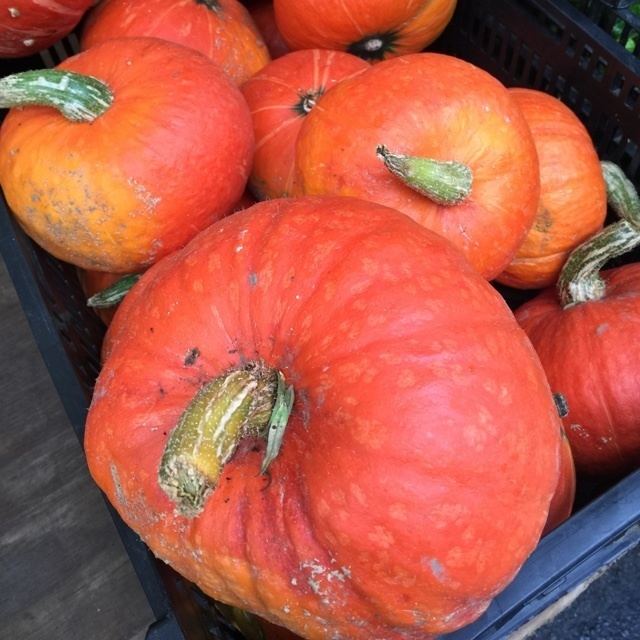Higher classification Winter squash | Rank Cultivar | |
 | ||
Similar Winter squash, Squash, Butternut squash, Crookneck pumpkin, Pattypan squash | ||
Red kuri squash
Red kuri squash (often spelled 'kari') (katakana: ウチキクリ) is thick-skinned pink colored winter squash, that has the appearance of a small pumpkin without the ridges. It belongs to the Hubbard squash group.
Contents

Inside the hard outer skin there is a firm flesh that provides a very delicate and mellow chestnut-like flavor. Red kuri squash is a cultivated variety of the species Cucurbita maxima. Other varieties of this subspecies include 'Hokkaido', 'Red Hokkaido' and 'Sweet Meat' squashes.

Cutting a red kuri squash
History

It is generally believed that all squash originated in Mesoamerica, but may have been independently cultivated elsewhere, albeit later.

Red kuri squash is commonly called "Japanese squash", "orange Hokkaido squash", "baby red hubbard squash", or "Uchiki kuri squash". In Japan, the word kuri may refer to either the squash discussed in this article or to Japanese chestnuts. In France, it is called potimarron, and in the United Kingdom, it is commonly called "onion squash".
Primarily grown in Japan, California, Florida, Southwestern Colorado, Mexico, Tasmania, Tonga, New Zealand, Chile, Provence, and South Africa, red kuri is widely adapted for climates that provide a growing season of 100 days or more. Most of the California, Colorado, Tonga and New Zealand crops are exported to Japan.
Characteristics

This hardy squash grows to maturity in full sun and is drought tolerant. Each vine produces multiple teardrop-shaped fruits, usually three. The squash matures after about ninety days after blooming.
The squash is a hard-shelled winter variety with firm yellow flesh. The flesh often has a green tint under the seeds.
Culinary uses
Full-flavored and sweet, red kuri squash is often cooked with butter and herbs. It is an ingredient in a variety of soups, stews and casseroles. It can be made into cakes, quick breads, muffins, cookies, jams and pies with its nutty-tasting flesh. It can be baked, boiled, microwaved, steamed, sautéed or fried. This squash adds sweet flavor and texture to stir-fries. Its seed cavity is ideal for stuffing.
Nutrition
Red kuri squash is a good source of fiber. It also provides vitamin A and vitamin C, some of the B vitamins, calcium, potassium, iron, riboflavin and thiamine. Low in calories and sodium, this deep-colored squash also contains beta-carotene. Nutrition facts : Nutrition Facts (1 cup cooked, cubes)
Calories 79.95 Protein 1.82 grams Carbohydrate 17.94 grams Dietary Fiber 5.74 grams Calcium 28.7 mg Iron 0.67 mg Potassium 895.85 mg Folate 57.40 mcg Vitamin A 7,291.85